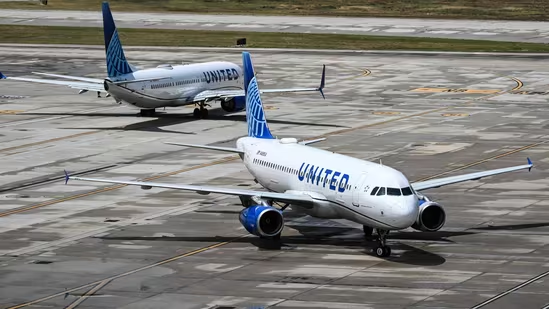Overview & Incident Summary
United 787‑8 Makes “Mayday” Call After Takeoff – What We Kno
On July 25, 2025, United Airlines Flight UA108, operated with a Boeing 787‑8 Dreamliner, declared a Mayday emergency shortly after departing Washington Dulles International Airport (IAD) en route to Munich. The aircraft reportedly suffered a malfunction in its left engine at around 5,000–6,000 feet, prompting swift and decisive action from the flight crew.
Following the declaration, the flight was placed in a holding pattern over the D.C. area, where the crew began an emergency fuel dump to reduce landing weight. Once cleared, the aircraft executed a safe return and landing at Dulles, though it required towing off the runway due to the disabled engine. No injuries were reported among the ten people on board.[https://www.hindustantimes.com/]
Timeline of Events
| Time (local) | Event |
|---|---|
| ~5:40 pm (Jul 25) | UA108 takes off from Dulles |
| Moments later | Left-engine malfunction detected |
| Seconds later | Pilot declares “Mayday, Mayday, Mayday” |
| Circling at ~6,000 ft | ATC directs fuel dump west of Dulles (~16 km out) |
| ~2 hours 38 min after | Aircraft remains airborne while managing emergency |
| Landing | Safe return to Dulles; aircraft towed due to engine fault |
Command & Coordination: ATC & Crew Communication
Audio transcripts from the radio exchange show calm but urgent coordination between the cockpit crew and Air Traffic Control (ATC). Dialogue captured on the “You Can See ATC” YouTube channel reveals:
- Pilot: “Failure. Engine failure. Left engine … declaring an emergency. Mayday, Mayday, Mayday.”
- ATC: “Heavy, roger that … are you able to make your way into the field … turn right heading 10 if able?”
- Pilot: “Right turn to 10 … left engine failure … souls on board ten … about five hours of flight time.”
- ATC: Offer to keep aircraft at 5,000 or loop again; pilot requested ILS on Runway 19 Center.
This interaction underscores effective crew training and seamless ATC coordination during high‑stress emergencies.
What Is a “Mayday” Call?
In aviation, a Mayday is the highest-level verbal distress signal, reserved for situations that pose imminent danger to flight safety—such as engine failure, fire, structural damage, or passenger medical crises.
The term—derived from the French m’aider (“help me”)—must be repeated three times, to ensure clarity over noisy radio channels. Once broadcast, all non-essential traffic on the frequency is suppressed to give priority to the emergency communication.
Context & Significance: UA108 vs Air India AI171
The UA108 incident occurred only a month after the catastrophic crash of Air India Flight AI171, also a Boeing 787‑8, which crashed near Ahmedabad on June 12, 2025, killing at least 260 people—one of India’s worst aviation disasters.
That tragedy began with a “Mayday, no thrust, losing power” call just seconds after liftoff around 625–650 ft, when crew reported total engine power loss. The aircraft nosedived into a residential neighborhood before crash crews could respond.
A subsequent preliminary investigation by India’s AAIB concluded that both engine fuel cutoff switches moved from “Run” to “Cutoff” within about one second of takeoff—starving the engines. Cockpit confusion followed, with neither pilot acknowledging toggling the switches. Though the engine relit, altitude was too low to recover.
Incident Response: UA108 vs AI171
- Outcome: UA108 returned safely with no injuries. AI171 crashed catastrophically, with high loss of life.
- Altitude at failure: UA108 (~5,000–6,000 ft); AI171 (~625–650 ft).
- Cause: UA108 engine malfunction (left engine issue); AI171 simultaneous fuel cut-off.
- Crew function: UA108 crew followed emergency procedures and communication was clear. AI171 crew issued Mayday within seconds, insufficient altitude/time to respond.
The contrasting outcomes highlight the difference that altitude, emergency response, and mechanisms behind the failure can make.
Safety Procedures & Emergency Techniques
1. Fuel Dump Procedure
For wide-body aircraft like the 787, fuel dumping is standard when landing weight needs to be reduced rapidly. UA108 conducted this maneuver while circling at ~6,000 ft, dumping fuel approximately 16 km west of Dulles. Rapid vaporization minimized environmental impact.
2. Holding Pattern
Maintaining a controlled altitude allowed pilots to manage the emergency revamp checklist, coordinate with ATC, and prepare for a stabilized approach rather than an immediate landing in an unstable configuration.
3. Aircraft Towing
After landing, UA108’s left engine was disabled, making it unsafe to taxi under its own power. The aircraft was towed off the runway—a precaution consistent with safety protocols.
Passenger & Crew Safety
UA108 had 10 souls on board—presumably reduced passenger count, possibly positioning or ferry flight. Despite the engine failure, all aboard remained safe, showcasing professionalism and training.
In contrast, AI171 had 242 aboard. With catastrophic failure and crash at low altitude, only 1 survived, tragically emphasizing how critical altitude and time are in emergencies.
Investigation & Regulatory Follow‑Up
Investigations are expected:
- United/FAA: Will review UA108’s engine logs, maintenance history, crew training, and operational response.
- India (AAIB): Already released a preliminary report on AI171, pointing to fuel switch error and cockpit confusion. Further collaboration with the UK’s AAIB and the NTSB is ongoing.
India’s Civil Aviation Minister has stressed these are still preliminary findings and the final report is awaited. All of Air India’s Boeing 787 fleet has been ordered inspected following the crash.
Public & Industry Reactions
- United Airlines: Expressed relief at no injuries and conveyed confidence in the crew.
- Passengers: Likely debriefed and offered support services; no injuries reported.
- Public perception: UA108 incident drew some media attention, but minimal due to benign outcome.
- Aviation community: Viewed UA108 as textbook emergency execution, contrasting sharply with AI171’s systemic failure and tragic consequences.
Broader Analysis of 787‑8 Reliability
Until 2025, no fatal crash had been linked to Boeing’s 787‑8 series. The AI171 crash marked the first-ever fatal accident involving a 787 Dreamliner model.
Prior to that, incidents included:
- January 2025: United UA613 from Lagos to Washington experienced altitude fluctuations mid-flight, injuring six. Crew returned safely.
- March 2025: A different United flight suffered navigation component failures, causing autopilot disengagement and injuries. Again, aircraft returned safely.
These underline that while technical issues can and do occur, robust crew response and system reliability generally yield safe outcomes.
Lessons Learned
a) Altitude & Time Are Critical
- AI171 had mere seconds at low altitude—no time to troubleshoot before impact.
- UA108 had sufficient altitude to execute fuel dump, checklist procedures, and coordinate return.
b) Emergency Communication Makes a Difference
- Clear, repeated Mayday calls and transparent communication with ATC enabled safe crisis management in UA108’s case.
c) Maintenance & Procedural Safeguards
- Engine failures must be anticipated in training.
- Fuel cutoff switches can be catastrophic—human factors must be evaluated closely.
- Redundancy systems and cockpit protocols should minimize risk of accidental switch movement.
d) Incident Review & Transparency
- Aviation authorities around the world (FAA, NTSB, AAIB) collaborate to ensure full transparency.
- Preliminary reports inform safety recommendations even before a full final report is issued.
What We Can Expect Next
- Detailed UA108 investigation: FAA and United will review engine telemetry, maintenance logs, and crew performance reports.
- Potential service bulletins or directives: If a technical fault is identified, it may result in fleet-wide checks or design modifications.
- Final AI171 crash report: India’s AAIB, with international partners, will produce a full investigation—including cockpit voice recorder analysis and final recommendations.
- Training updates: Airlines—and Boeing—may re‑evaluate emergency drills related to fuel management and engine failures.
In Summary
United Airlines Flight UA108’s safe handling of a serious left-engine failure and declaration of Mayday demonstrates effective crisis management, enabling the aircraft to return safely with no injuries.
This stands in stark contrast to the earlier Air India AI171 crash on June 12, where catastrophic fuel cut‑off at extremely low altitude led to tragedy despite the crew’s emergency call.
Both incidents highlight how altitude, crew response, and system behavior critically shape outcomes in in‑flight emergencies.



